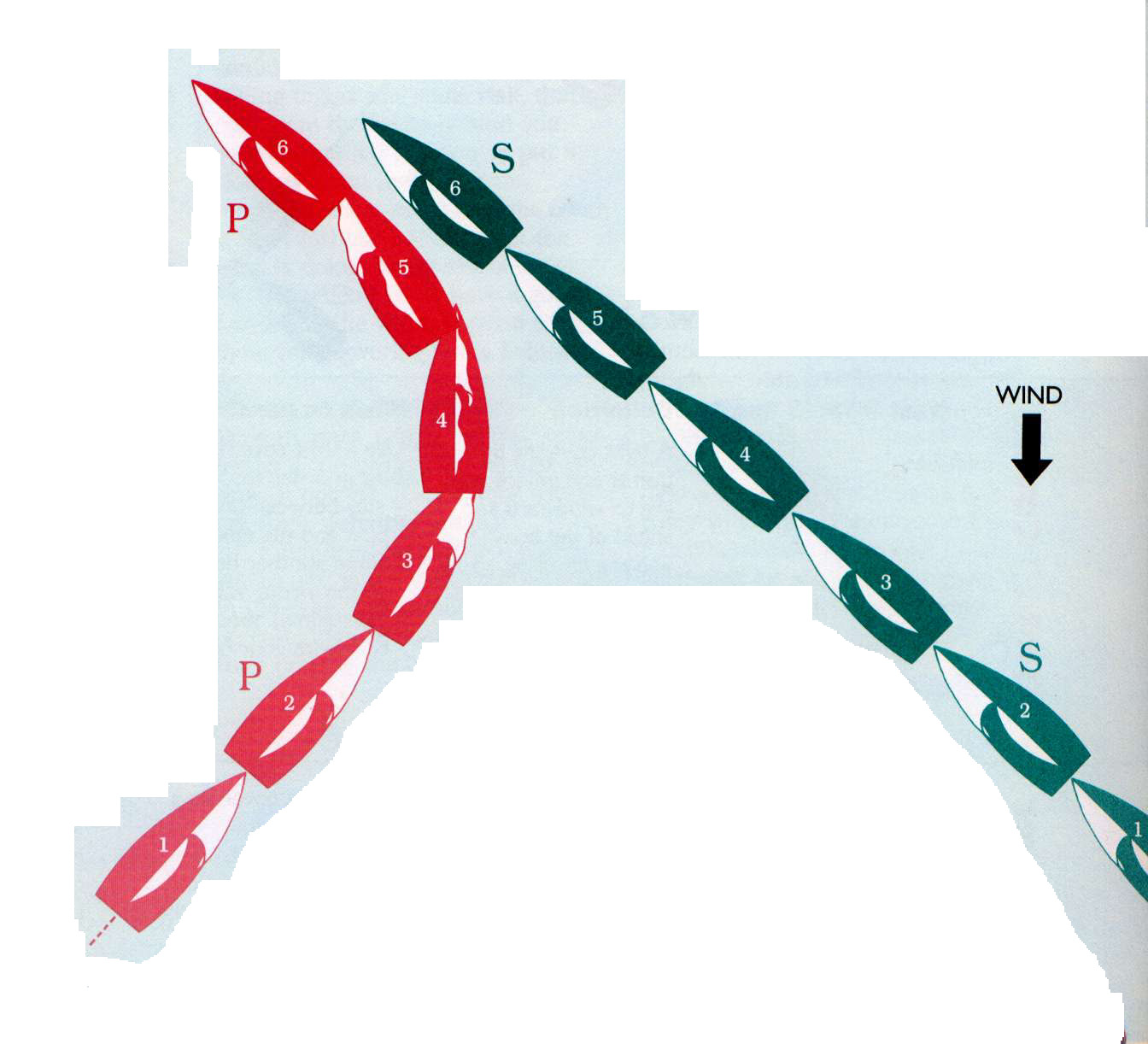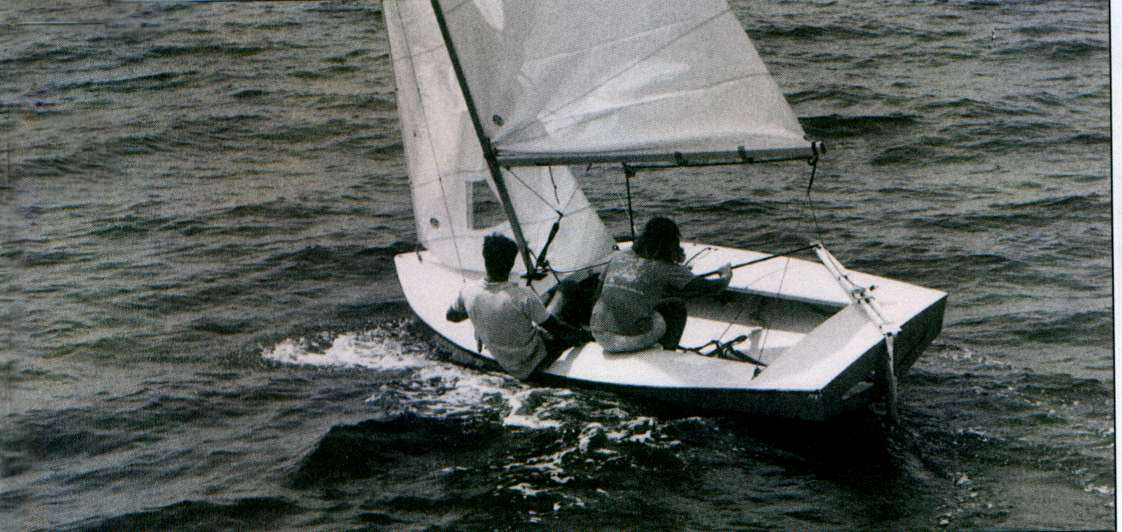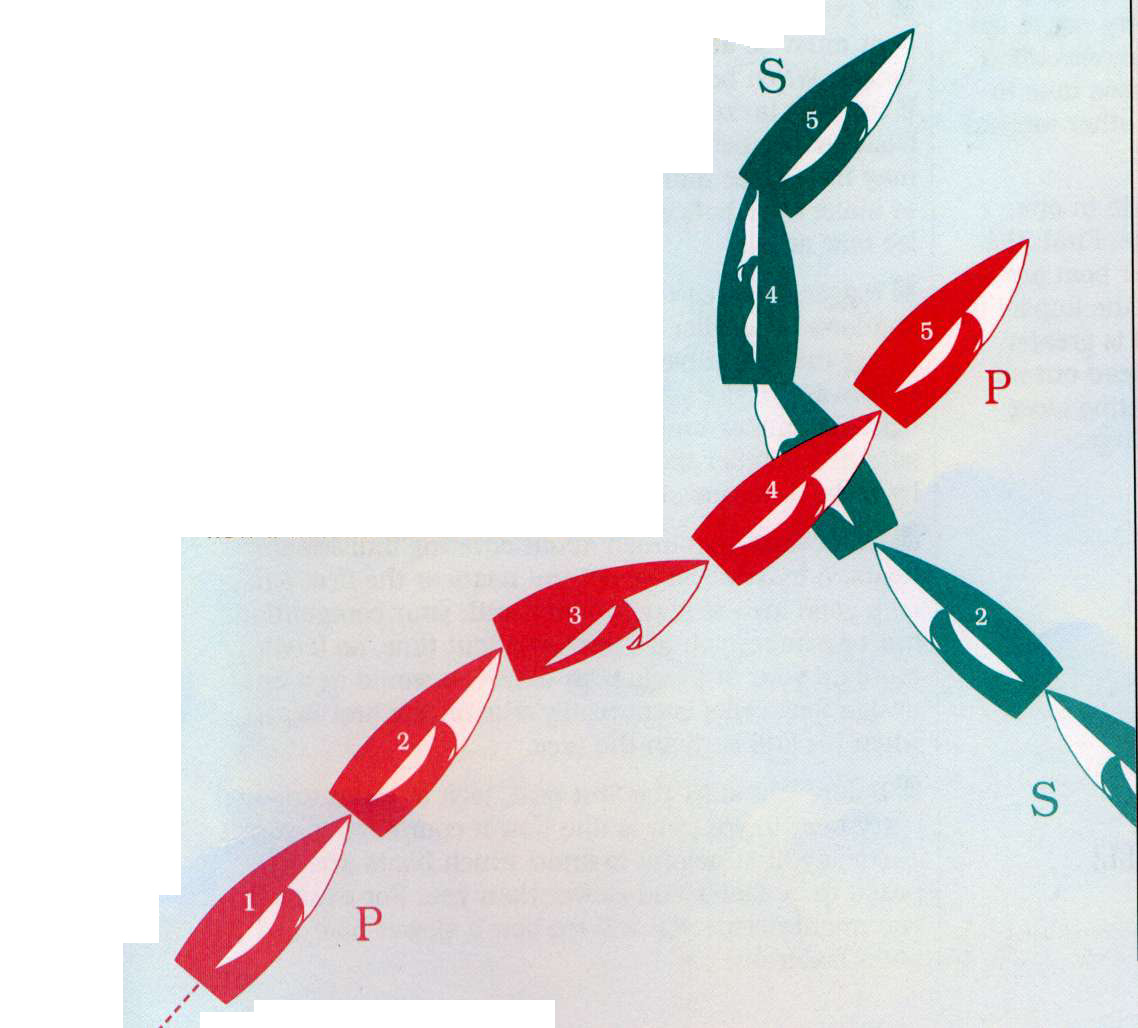Watch Out When You’re Tacking
by David Dellenbaugh
On any first beat there is usually a lot of tacking, and this gives rule 13 (see box) a good workout. The wording of this rule is slightly different than in previous rulebooks, but its intent is still the same; Boats that are tacking must keep clear of boats on a tack.
13 WHILE TACKING
After a boat passes head to wind, she shall keep clear of other boats until she is on a close-hauled course. During that time rules 10, 11 and 12 do not apply. If two boats are subject to this rule at the same time, the one on the other’s port side shall keep clear. |
Of course, the term “tacking” is no longer defined in the rulebook. That’s why the text of rule 13 does not go into effect until the moment a boat passes head to wind. The rule continues to apply until the boat is on a close-hauled course, and then it turns off.
 |
| The ‘Lee - Bow” Tack
A common move in fleet racing is the “lee-bow” tack (i.e. a tack into a safe leeward position). It usually happens when a port tacker (P) tacks just ahead and to leeward of a starboard tacker (S). If done successfully, this puts P in a strong position and S in a tough spot. However, P must be careful she doesn’t tack too close.
As the two boats converge on opposite tacks (positions 1 and 2), S has the right of way because she is on starboard tack, so P must keep clear (rule 10). At position 3, P begins luffing up into a tack; she is still on port tack and must therefore keep clear of S under rule 10.
P continues turning until she is head to wind at position 4. She is still on port tack here (see the definitions), and she must keep clear of S. Rule 13 does not begin to apply yet because P has not passed head to wind. At position 5, P is on starboard tack. However, she is subject to rule 13 now because she has gone past closehauled but hasn’t yet reached a closehauled course. So P must continue keeping clear of S.
At position 6, S reaches a closehauled course on starboard tack, so rule 13 no longer applies. At this moment, the right of way changes from S to P, since P is now a leeward boat not subject to rule 13. S must begin keeping clear (rule 11), and P must initially give S room to do so (see rule 15 - Acquiring Right of Way).
|
While a boat is subject to rule 13, she must keep clear of other boats. In other words, she must allow all other boats to sail their courses and not cause them to take avoiding action. The only exception is when two boats are subject to rule 13 at the same time (this might happen when P ducks S and then both tack). In that case, the boat on the other one’s port side (S) must keep clear.
Note that when rule 13 applies, rules 10 (Opposite Tacks), 11 (Same tack - Overlapped) and 12 (Same Tack - Not Overlapped) do not apply. To see one case when this makes a difference, look at the diagram on this page where a port tack boat (P) tacks on the lee bow of a starboard tacker (S).
At position 5, boat P has gone past head to wind and she is on starboard tack. If rule 13 did not exist, P has gone past head to wind and she is on starboard tack. If rule 13 did not exist, P would have right of way as a leeward boat at that point, and S (as windward boat) would have to keep clear of her under rule 11. However, rule 13 specifically turns off rule 11, so the boats are governed only by rule 13, which requires P to keep clear.
Once P reaches a closehauled course (position 6), rule 13 turns off and the other three rules turn on again. At that point P gains the right of way as a leeward boat.
 |
| According to racing rule 13 (While Tacking), a boat that is tacking must keep clear of other boats from the moment she passes head to wind until she reaches a close-hauled course. This Snipe is in the middle of a tack from port to starboard. Until she passes head to wind, she will be on starboard tack. However, rule 13 says she must keep clear of all other boats until she reaches her closehauled course on starboard tack. At that point rule 13 turns off and she regains her “normal” rights. |
A few years ago, the rule about tacking too close placed an onus on the boat that was tacking. Because of this, many boats that made leebow tacks were disqualified. There is no longer any onus in the rule, but it’s still hard for a tacking boat to prove she didn’t break rule 13.
All the starboard tacker has to say in a protest hearing is that she had to change her course (to avoid contact) before the tacking boat reached a closehauled course. If the jury finds this as a fact, the tacker will be penalized.
 |
The “Slam Dunk” Tack
In the slam dunk maneuver, a boat on starboard tack (S) crosses just ahead of a port tacker (P) and then tacks as P is ducking her. If S does this right, she will end up with total control, to windward and slightly ahead of P. Though this maneuver is commonly used in match racing, it’s a bit risky for fleet racing, and you don’t normally need that kind of control over one other boat. However, I am including it here because it’s educational from a rules point of view.
As the two boats converge with each other on opposite tacks (positions 1 and 2), S has the right of way (rule 10) so P decides to keep clear by ducking. At postion 3, P begins to bear off to pass astern of S, and S starts luffing into a tack. S still has the right of way here, but according to rule 16.1 (Changing Course), if S changes her course (as she is doing) she must give P room to keep clear. In addition, S may not change her course if as a result P would immediately need to change course to keep clear (rule 16.2).
So S has to be careful here. She wants to tack as soon as possible to pin P, but she can’t change her course right in front of P. Usually the best move for S is to wait until P bears off enough so her bow is pointing behind S’s stern. Then S can turn fully into a tack, since this course change will no longer interfere with P.
At position 4, S is head to wind and still on starboard tack, so she still has the right of way. However, once when turns a little more she is subject to rule 13 and must begin keeping clear of P. At position 5, rule 13 turns off. S is now a windward boat and in control.
|
More notes on tacking
Here are some other ideas on rules and tacktics related to tacking:
• Since you lose the right of way while tacking, make sure you look around for other boats before you just throw the helm over.
• In most boats and most conditions you will lose distance every time you tack, so don’t tack unless you have a good reason.
• When you lee-bow another boat, try to make your normal, max-VMG tack. Don’t rush your tack or slow it down since these will lose distance to your optimal turn.
• You can lee-bow a port tacker, too, but this is trickier. You must begin your tack a little sooner, and you can’t sail as close to the other boat as you’d like. Usually you can wait until the port tacker starts to bear off behind you, but don’t wait so long that she will have to change her course to avoid hitting you.
• If you are to leeward of another boat and you do not have the right to sail above your proper course, it’s still OK to tack as long as you then pass behind the other boat without interfering (rule 17.1).
• When you complete a tack, look to windward and leeward to see if you have established any overlaps with other boats. This could be important for knowing whether you (or another boat) have the right to sail above your proper course later on (rule 17.1). |
What can we learn from this? First, make sure you understand your obligations under rule 13. Second, don’t push your luck with this rule. When you make a lee bow tack, leave a little extra space, especially if you’re tacking near someone who’s inclined to protest.
Dave is a two-time America’s Cup veteran who publishes the newsletter Speed & Smarts. For a subscription call: 800-356-2200.


